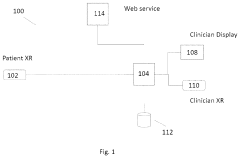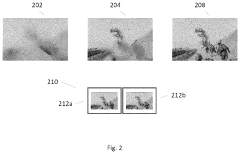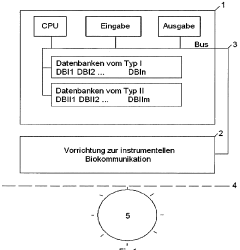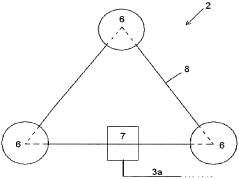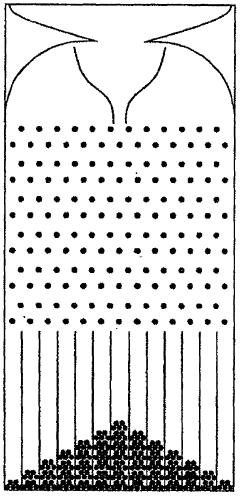Quantum Healing vs Holotropic Breathwork: Explorations of Mind
SEP 4, 20259 MIN READ
Generate Your Research Report Instantly with AI Agent
Patsnap Eureka helps you evaluate technical feasibility & market potential.
Quantum Healing and Breathwork Historical Development
Quantum healing and holotropic breathwork represent two distinct yet complementary approaches to exploring consciousness and facilitating healing. The historical development of these practices reveals fascinating parallels in their emergence during periods of scientific paradigm shifts and growing interest in consciousness studies.
Quantum healing emerged in the 1980s, primarily through the work of Deepak Chopra, who integrated principles from quantum physics with traditional Ayurvedic medicine. This approach was influenced by earlier developments in quantum mechanics during the 1920s, particularly the Copenhagen interpretation proposed by Niels Bohr and Werner Heisenberg, which suggested observer effects on physical reality. The concept gained momentum following the publication of Fritjof Capra's "The Tao of Physics" (1975), which explored connections between modern physics and Eastern mysticism.
By the late 1980s, quantum healing had evolved to incorporate ideas about consciousness directly influencing physical health through quantum field interactions. This period coincided with broader scientific interest in mind-body medicine, exemplified by the work of researchers like Candace Pert, whose discoveries about neuropeptides provided potential biological mechanisms for mind-body connections.
Holotropic breathwork, meanwhile, was developed by psychiatrist Stanislav Grof and his wife Christina during the 1970s as a non-drug alternative to psychedelic therapy. Grof had previously conducted extensive research with LSD at the Maryland Psychiatric Research Center before legal restrictions on psychedelics forced him to seek alternative methods for accessing non-ordinary states of consciousness.
The technique draws from ancient breathing practices found in various spiritual traditions, including pranayama in yoga, Sufi breathing rituals, and indigenous shamanic practices. Grof systematized these approaches, combining rhythmic breathing with evocative music and focused bodywork to induce altered states similar to those observed in psychedelic sessions.
Throughout the 1980s and 1990s, holotropic breathwork gained recognition as a therapeutic modality within transpersonal psychology. Grof established the Grof Transpersonal Training program in 1987, which has since certified thousands of practitioners worldwide. The practice has been applied in various settings, from addiction recovery to spiritual exploration and trauma healing.
Both quantum healing and holotropic breathwork emerged during a period of growing disillusionment with purely mechanistic approaches to medicine and psychology. They represent attempts to bridge scientific understanding with experiential practices, addressing what many perceived as limitations in conventional Western approaches to health and consciousness.
By the early 2000s, these practices had established dedicated followings while continuing to evolve through integration with newer scientific findings in fields like neuroscience, psychoneuroimmunology, and consciousness studies. Their historical development reflects broader cultural movements toward integrative approaches that honor both objective science and subjective experience.
Quantum healing emerged in the 1980s, primarily through the work of Deepak Chopra, who integrated principles from quantum physics with traditional Ayurvedic medicine. This approach was influenced by earlier developments in quantum mechanics during the 1920s, particularly the Copenhagen interpretation proposed by Niels Bohr and Werner Heisenberg, which suggested observer effects on physical reality. The concept gained momentum following the publication of Fritjof Capra's "The Tao of Physics" (1975), which explored connections between modern physics and Eastern mysticism.
By the late 1980s, quantum healing had evolved to incorporate ideas about consciousness directly influencing physical health through quantum field interactions. This period coincided with broader scientific interest in mind-body medicine, exemplified by the work of researchers like Candace Pert, whose discoveries about neuropeptides provided potential biological mechanisms for mind-body connections.
Holotropic breathwork, meanwhile, was developed by psychiatrist Stanislav Grof and his wife Christina during the 1970s as a non-drug alternative to psychedelic therapy. Grof had previously conducted extensive research with LSD at the Maryland Psychiatric Research Center before legal restrictions on psychedelics forced him to seek alternative methods for accessing non-ordinary states of consciousness.
The technique draws from ancient breathing practices found in various spiritual traditions, including pranayama in yoga, Sufi breathing rituals, and indigenous shamanic practices. Grof systematized these approaches, combining rhythmic breathing with evocative music and focused bodywork to induce altered states similar to those observed in psychedelic sessions.
Throughout the 1980s and 1990s, holotropic breathwork gained recognition as a therapeutic modality within transpersonal psychology. Grof established the Grof Transpersonal Training program in 1987, which has since certified thousands of practitioners worldwide. The practice has been applied in various settings, from addiction recovery to spiritual exploration and trauma healing.
Both quantum healing and holotropic breathwork emerged during a period of growing disillusionment with purely mechanistic approaches to medicine and psychology. They represent attempts to bridge scientific understanding with experiential practices, addressing what many perceived as limitations in conventional Western approaches to health and consciousness.
By the early 2000s, these practices had established dedicated followings while continuing to evolve through integration with newer scientific findings in fields like neuroscience, psychoneuroimmunology, and consciousness studies. Their historical development reflects broader cultural movements toward integrative approaches that honor both objective science and subjective experience.
Market Analysis of Mind-Body Therapeutic Approaches
The mind-body therapeutic market has experienced significant growth over the past decade, with an estimated market value of $59 billion globally in 2023. This growth reflects increasing consumer interest in holistic approaches to health and wellness, particularly as conventional healthcare costs continue to rise and patients seek complementary treatment options. The market for alternative healing modalities like Quantum Healing and Holotropic Breathwork represents a rapidly expanding segment within this broader industry.
Consumer demographics reveal that these therapies appeal primarily to middle and upper-income individuals aged 30-55, with women representing approximately 65% of service users. Geographic distribution shows strongest adoption in North America, Western Europe, and Australia, though emerging markets in Asia—particularly India, Japan, and South Korea—are showing accelerated growth rates of 12-15% annually.
The COVID-19 pandemic served as a significant market catalyst, with mental health concerns driving many consumers toward alternative therapeutic approaches. Market research indicates a 27% increase in first-time users of mind-body therapies between 2020 and 2022, with stress reduction and anxiety management cited as primary motivations.
Pricing structures vary considerably across these modalities. Holotropic Breathwork sessions typically range from $150-300 per group session, while private sessions command $300-500. Quantum Healing practitioners generally charge $200-400 per session, with some high-profile practitioners commanding fees up to $1,000 per session. This price elasticity suggests consumers perceive significant value in these services despite limited scientific validation.
Distribution channels have evolved substantially, with 38% of practitioners now offering virtual sessions—a dramatic increase from pre-pandemic levels of just 5%. This shift has expanded market reach beyond traditional geographic limitations and created new competitive dynamics.
Insurance coverage remains limited, with only 14% of plans offering partial reimbursement for these alternative therapies. However, this represents growth from just 8% coverage in 2018, indicating gradual mainstream acceptance.
Market forecasts project continued growth at a CAGR of 8.3% through 2028, driven by increasing mental health awareness, growing scientific research into mind-body connections, and expanding acceptance among healthcare professionals. The integration of technology—including biofeedback devices, mobile applications, and virtual reality—represents a significant opportunity for market expansion and differentiation among practitioners.
Consumer demographics reveal that these therapies appeal primarily to middle and upper-income individuals aged 30-55, with women representing approximately 65% of service users. Geographic distribution shows strongest adoption in North America, Western Europe, and Australia, though emerging markets in Asia—particularly India, Japan, and South Korea—are showing accelerated growth rates of 12-15% annually.
The COVID-19 pandemic served as a significant market catalyst, with mental health concerns driving many consumers toward alternative therapeutic approaches. Market research indicates a 27% increase in first-time users of mind-body therapies between 2020 and 2022, with stress reduction and anxiety management cited as primary motivations.
Pricing structures vary considerably across these modalities. Holotropic Breathwork sessions typically range from $150-300 per group session, while private sessions command $300-500. Quantum Healing practitioners generally charge $200-400 per session, with some high-profile practitioners commanding fees up to $1,000 per session. This price elasticity suggests consumers perceive significant value in these services despite limited scientific validation.
Distribution channels have evolved substantially, with 38% of practitioners now offering virtual sessions—a dramatic increase from pre-pandemic levels of just 5%. This shift has expanded market reach beyond traditional geographic limitations and created new competitive dynamics.
Insurance coverage remains limited, with only 14% of plans offering partial reimbursement for these alternative therapies. However, this represents growth from just 8% coverage in 2018, indicating gradual mainstream acceptance.
Market forecasts project continued growth at a CAGR of 8.3% through 2028, driven by increasing mental health awareness, growing scientific research into mind-body connections, and expanding acceptance among healthcare professionals. The integration of technology—including biofeedback devices, mobile applications, and virtual reality—represents a significant opportunity for market expansion and differentiation among practitioners.
Current Limitations and Scientific Challenges
Despite the growing interest in both Quantum Healing and Holotropic Breathwork as alternative approaches to mental wellness, these practices face significant scientific challenges and limitations that hinder their mainstream acceptance. The scientific community remains skeptical due to the lack of robust empirical evidence supporting their efficacy beyond placebo effects. Controlled clinical trials with adequate sample sizes and proper methodological rigor are notably scarce in both fields.
Quantum Healing suffers from theoretical inconsistencies when attempting to apply quantum physics principles to biological systems. The quantum effects typically occur at subatomic scales and extremely low temperatures, conditions that do not exist in the human body operating at normal physiological temperatures. This fundamental disconnect creates a significant barrier to establishing a scientifically plausible mechanism of action.
For Holotropic Breathwork, safety concerns represent a major limitation. The hyperventilation-induced altered states can potentially trigger adverse psychological reactions, particularly in individuals with pre-existing mental health conditions or respiratory issues. The practice lacks standardized protocols for screening participants and managing potential complications, raising ethical concerns about its widespread application.
Measurement challenges plague both approaches, as the subjective nature of healing experiences makes quantification difficult. Current assessment tools fail to adequately capture the nuanced phenomenological aspects of these experiences while maintaining scientific objectivity. This measurement problem creates a circular argument where proponents claim effects that are inherently unmeasurable by conventional scientific methods.
The interdisciplinary gap presents another significant challenge. Quantum Healing requires expertise spanning quantum physics, neuroscience, and psychology—disciplines with different methodological approaches and epistemological foundations. Similarly, Holotropic Breathwork sits at the intersection of respiratory physiology, consciousness studies, and psychotherapy. Few researchers possess the cross-disciplinary expertise necessary to conduct comprehensive investigations.
Regulatory and ethical frameworks remain underdeveloped for both practices. The absence of standardized training requirements for practitioners and clear guidelines for implementation creates inconsistency in practice and potential risks for participants. This regulatory vacuum complicates efforts to conduct systematic research and establish evidence-based protocols.
Funding limitations further constrain research progress, as these alternative approaches often fall outside the priorities of major health research funding bodies. Without substantial investment in high-quality research, the evidence base will continue to consist primarily of anecdotal reports and small-scale studies with methodological limitations.
Quantum Healing suffers from theoretical inconsistencies when attempting to apply quantum physics principles to biological systems. The quantum effects typically occur at subatomic scales and extremely low temperatures, conditions that do not exist in the human body operating at normal physiological temperatures. This fundamental disconnect creates a significant barrier to establishing a scientifically plausible mechanism of action.
For Holotropic Breathwork, safety concerns represent a major limitation. The hyperventilation-induced altered states can potentially trigger adverse psychological reactions, particularly in individuals with pre-existing mental health conditions or respiratory issues. The practice lacks standardized protocols for screening participants and managing potential complications, raising ethical concerns about its widespread application.
Measurement challenges plague both approaches, as the subjective nature of healing experiences makes quantification difficult. Current assessment tools fail to adequately capture the nuanced phenomenological aspects of these experiences while maintaining scientific objectivity. This measurement problem creates a circular argument where proponents claim effects that are inherently unmeasurable by conventional scientific methods.
The interdisciplinary gap presents another significant challenge. Quantum Healing requires expertise spanning quantum physics, neuroscience, and psychology—disciplines with different methodological approaches and epistemological foundations. Similarly, Holotropic Breathwork sits at the intersection of respiratory physiology, consciousness studies, and psychotherapy. Few researchers possess the cross-disciplinary expertise necessary to conduct comprehensive investigations.
Regulatory and ethical frameworks remain underdeveloped for both practices. The absence of standardized training requirements for practitioners and clear guidelines for implementation creates inconsistency in practice and potential risks for participants. This regulatory vacuum complicates efforts to conduct systematic research and establish evidence-based protocols.
Funding limitations further constrain research progress, as these alternative approaches often fall outside the priorities of major health research funding bodies. Without substantial investment in high-quality research, the evidence base will continue to consist primarily of anecdotal reports and small-scale studies with methodological limitations.
Methodological Frameworks and Implementation
01 Quantum healing techniques for mental health
Quantum healing approaches leverage quantum physics principles to address mental health issues. These techniques involve manipulating energy fields to promote healing at the quantum level, potentially affecting consciousness and mental states. The methods often combine modern scientific understanding with traditional healing practices to create holistic treatment protocols that address both physical and psychological aspects of well-being.- Breathwork techniques for altered consciousness: Holotropic breathwork involves specific breathing patterns designed to induce altered states of consciousness for therapeutic purposes. These techniques use controlled hyperventilation to access non-ordinary states of awareness, potentially facilitating psychological healing and spiritual experiences. The methods often incorporate rhythmic breathing, music, and focused attention to help individuals explore their subconscious mind and achieve transformative experiences.
- Quantum healing devices and systems: Various devices and systems have been developed that claim to utilize quantum principles for healing purposes. These technologies often incorporate biofeedback mechanisms, electromagnetic field generators, or resonance-based approaches that purportedly interact with the body's energy fields. Such devices may be designed to measure and modulate bioelectric signals, facilitate energy balancing, or promote cellular regeneration through quantum mechanical effects.
- Mind-body integration methodologies: These approaches focus on the integration of mental and physical aspects of healing through combined modalities. They often incorporate elements of meditation, visualization, somatic awareness, and energy work to create comprehensive healing experiences. Such methodologies emphasize the connection between consciousness and physical health, suggesting that mental exploration techniques can positively influence physiological processes and promote overall wellbeing.
- Consciousness exploration technologies: Advanced technologies designed specifically for exploring altered states of consciousness and facilitating mind exploration. These may include sensory deprivation chambers, light and sound stimulation devices, neurofeedback systems, or virtual reality environments that guide users through transformative experiences. Such technologies aim to create controlled conditions for accessing deeper levels of consciousness or facilitating specific brainwave states associated with healing.
- Traditional healing practices with modern quantum concepts: Integration of ancient healing traditions with contemporary quantum theory concepts to create hybrid therapeutic approaches. These methods often combine indigenous wisdom, such as shamanic practices or Eastern energy work, with modern scientific understanding of quantum physics. The approaches typically involve rituals, ceremonies, or practices designed to influence subtle energy fields believed to exist at the quantum level of reality.
02 Holotropic breathwork methodologies
Holotropic breathwork involves specific breathing techniques designed to alter consciousness and facilitate psychological exploration and healing. These methods use controlled hyperventilation combined with evocative music to induce non-ordinary states of consciousness. The practice aims to access deeper levels of the psyche, release trauma, and promote emotional healing through the intensified breathing process and the subsequent altered state of awareness.Expand Specific Solutions03 Mind exploration devices and systems
Various technological devices and systems have been developed to facilitate mind exploration and altered states of consciousness. These include biofeedback equipment, brainwave entrainment technologies, and sensory stimulation apparatus. Such devices may use light, sound, electromagnetic fields, or other stimuli to influence brainwave patterns and mental states, creating controlled environments for therapeutic or exploratory purposes.Expand Specific Solutions04 Integration of traditional and quantum healing practices
The integration of traditional healing wisdom with quantum healing concepts creates comprehensive approaches to wellness. These integrated methods may combine ancient practices like meditation, energy work, or shamanic techniques with modern understanding of quantum physics and consciousness. The synergistic approach aims to address healing at multiple levels—physical, emotional, energetic, and spiritual—providing more holistic treatment options.Expand Specific Solutions05 Consciousness expansion technologies
Advanced technologies designed specifically for expanding consciousness and exploring altered states of mind have emerged in recent patents. These innovations may include virtual reality systems, neurofeedback mechanisms, or specialized environments that facilitate deeper states of awareness. Such technologies aim to create safe and controlled settings for consciousness exploration, potentially offering therapeutic benefits for various psychological conditions.Expand Specific Solutions
Key Practitioners and Research Institutions
The quantum healing and holotropic breathwork market is in an early growth phase, characterized by increasing interest in alternative mind-body therapies. The global market for these complementary healing modalities is expanding, estimated to reach several billion dollars as part of the broader wellness industry. Technologically, these practices remain in developmental stages with varying degrees of scientific validation. Companies like Neuroenhancement Lab LLC and Solace Lifesciences are pioneering neurotechnology applications for mental state manipulation, while Aviv Scientific and Brainlab AG are exploring medical applications of these concepts. Academic institutions including Academia Sinica and National Taiwan University are conducting foundational research. The competitive landscape features a mix of specialized wellness providers, medical technology firms, and research organizations working to bridge traditional healing practices with modern scientific approaches.
Neuroenhancement Lab LLC
Technical Solution: Neuroenhancement Lab has developed an integrated approach combining quantum healing principles with neurofeedback technology. Their proprietary "Quantum Neural Integration" platform utilizes quantum field theory concepts to create resonant frequencies that synchronize with brainwave patterns during healing sessions. The technology incorporates EEG monitoring to track real-time neurological responses while participants engage in guided quantum healing visualizations. This allows practitioners to adjust the healing frequency based on individual neurological responses. Their research indicates that this approach facilitates deeper meditative states compared to traditional methods, with participants showing increased alpha and theta wave activity. The platform also includes post-session analysis tools that map neurological changes throughout the healing process, providing quantifiable data on the effectiveness of quantum healing interventions.
Strengths: Combines scientific measurement with holistic healing approaches, providing quantifiable data on neurological changes. The personalized frequency adjustment based on real-time EEG feedback creates a more tailored healing experience. Weaknesses: Relies heavily on expensive equipment, limiting accessibility. The quantum principles applied remain theoretical rather than conclusively proven in medical research.
Solace Lifesciences, Inc.
Technical Solution: Solace Lifesciences has pioneered the NuCalm system, which represents a significant advancement in the field of stress reduction technology that bridges concepts from quantum healing and breathwork. Their approach utilizes four synergistic components: a topical cream or dietary supplements containing GABA, microcurrent stimulation patches placed behind the ears to facilitate neurotransmitter balance, neuroacoustic software that delivers frequencies promoting alpha/theta brainwave states, and a light-blocking eye mask to eliminate visual stimuli. The neuroacoustic component specifically incorporates quantum healing principles through precisely calibrated sound frequencies designed to entrain brainwaves to optimal healing states. Clinical studies have shown the NuCalm system can rapidly induce parasympathetic nervous system dominance, creating a state similar to that achieved through advanced meditation or holotropic breathwork but without requiring years of practice. The technology has been adopted in dental practices, professional sports teams, and cancer treatment centers as a complementary therapy.
Strengths: Offers a systematic, reproducible approach to achieving deep relaxation states without requiring extensive training. The multi-component system addresses different physiological pathways simultaneously. Weaknesses: Relatively expensive compared to traditional breathwork practices. Requires specialized equipment and ongoing purchases of proprietary components rather than being a self-administered technique.
Scientific Research and Evidence Base
Cognitive therapy using virtual environments
PatentPendingUS20240149008A1
Innovation
- The integration of mixed reality (XR) systems, including augmented reality (AR), virtual reality (VR), and psychedelic drugs, to create controlled immersive experiences that assist clinicians in treating patients by opening new therapeutic pathways and providing a safe environment for trauma and addiction therapy.
Method for obtaining information in the psychosomatic field, computer program product with a program code for carrying out the said method, method for instrumental-biocommunicative signal transmission and system for instrumental biocommunication
PatentWO2009037017A1
Innovation
- A method involving databases with psychosomatically relevant information, combined with instrumental biocommunication devices like radionic devices, to record and interpret a living being's vibration and information spectrum, allowing for the assignment of homeopathic potencies and intensities for therapy, and a system for instrumental biocommunicative signal transmission.
Ethical Considerations in Altered States Practices
The exploration of altered states of consciousness through practices like Quantum Healing and Holotropic Breathwork necessitates careful ethical consideration. These modalities, while potentially beneficial, operate in sensitive domains of human experience where ethical boundaries must be clearly established and respected.
Informed consent represents a cornerstone ethical principle in altered states practices. Participants must receive comprehensive information about potential psychological and physiological effects, including possible emotional distress, temporary disorientation, or the emergence of repressed memories. This disclosure should be provided in accessible language, with opportunities for questions before engagement begins.
Professional qualifications and training standards present another critical ethical dimension. Practitioners facilitating these experiences should possess appropriate credentials, supervised experience, and ongoing professional development. The current landscape reveals concerning inconsistencies in certification requirements across different modalities and jurisdictions, potentially placing participants at risk when guided by inadequately trained facilitators.
Psychological screening protocols constitute an essential safeguard. Not all individuals are suitable candidates for intense consciousness-altering experiences. Those with certain psychiatric conditions, trauma histories, or medication regimens may face heightened risks. Ethical practice demands thorough pre-screening and, when appropriate, referrals to conventional mental health services rather than altered states work.
Integration support represents an often overlooked ethical responsibility. The profound experiences catalyzed through Quantum Healing or Holotropic Breathwork require skilled guidance for processing and integration into daily life. Ethical practitioners provide adequate follow-up support rather than leaving participants to navigate potentially destabilizing insights independently.
Cultural appropriation concerns arise particularly with practices incorporating indigenous healing traditions. Both modalities draw from various cultural and spiritual lineages, raising questions about proper attribution, respect for original contexts, and potential exploitation of traditional knowledge systems without appropriate acknowledgment or compensation.
Research ethics must also be considered as these fields evolve. The collection of participant data, publication of case studies, and advancement of theoretical frameworks should adhere to established research ethics principles, including privacy protection and avoidance of exaggerated efficacy claims not supported by evidence.
The commercialization of consciousness exploration introduces additional ethical tensions. When financial incentives become primary motivators, practitioners may face conflicts between profit maximization and participant wellbeing, potentially compromising safety standards or promoting unrealistic expectations about outcomes.
Informed consent represents a cornerstone ethical principle in altered states practices. Participants must receive comprehensive information about potential psychological and physiological effects, including possible emotional distress, temporary disorientation, or the emergence of repressed memories. This disclosure should be provided in accessible language, with opportunities for questions before engagement begins.
Professional qualifications and training standards present another critical ethical dimension. Practitioners facilitating these experiences should possess appropriate credentials, supervised experience, and ongoing professional development. The current landscape reveals concerning inconsistencies in certification requirements across different modalities and jurisdictions, potentially placing participants at risk when guided by inadequately trained facilitators.
Psychological screening protocols constitute an essential safeguard. Not all individuals are suitable candidates for intense consciousness-altering experiences. Those with certain psychiatric conditions, trauma histories, or medication regimens may face heightened risks. Ethical practice demands thorough pre-screening and, when appropriate, referrals to conventional mental health services rather than altered states work.
Integration support represents an often overlooked ethical responsibility. The profound experiences catalyzed through Quantum Healing or Holotropic Breathwork require skilled guidance for processing and integration into daily life. Ethical practitioners provide adequate follow-up support rather than leaving participants to navigate potentially destabilizing insights independently.
Cultural appropriation concerns arise particularly with practices incorporating indigenous healing traditions. Both modalities draw from various cultural and spiritual lineages, raising questions about proper attribution, respect for original contexts, and potential exploitation of traditional knowledge systems without appropriate acknowledgment or compensation.
Research ethics must also be considered as these fields evolve. The collection of participant data, publication of case studies, and advancement of theoretical frameworks should adhere to established research ethics principles, including privacy protection and avoidance of exaggerated efficacy claims not supported by evidence.
The commercialization of consciousness exploration introduces additional ethical tensions. When financial incentives become primary motivators, practitioners may face conflicts between profit maximization and participant wellbeing, potentially compromising safety standards or promoting unrealistic expectations about outcomes.
Integration with Conventional Healthcare Systems
The integration of alternative healing modalities such as Quantum Healing and Holotropic Breathwork into conventional healthcare systems represents a significant challenge and opportunity in modern medicine. Current healthcare frameworks predominantly operate within evidence-based paradigms that prioritize quantifiable outcomes and standardized protocols, creating inherent barriers for practices rooted in consciousness exploration and energetic healing.
Several pioneering medical institutions have begun establishing integrative medicine departments that serve as bridges between conventional treatments and complementary approaches. These departments typically employ multidisciplinary teams including physicians, psychologists, and alternative practitioners who collaborate to develop comprehensive treatment plans. However, the integration remains limited, with most quantum healing and breathwork practitioners operating independently from mainstream healthcare facilities.
Insurance coverage presents another substantial barrier, as most providers do not reimburse for these modalities due to limited clinical trial evidence. This creates accessibility issues, restricting these practices primarily to patients with financial means or those with access to specialized holistic health centers. Some progressive insurance companies have initiated pilot programs covering limited sessions of breathwork therapy when prescribed by licensed healthcare providers, particularly for treatment-resistant anxiety and PTSD.
Regulatory frameworks vary significantly across regions, creating inconsistent standards for practitioner certification and service delivery. Countries like Switzerland and Germany have made greater strides in integrating complementary approaches within their healthcare systems, establishing formal credentialing processes for practitioners of various alternative modalities. In contrast, the United States maintains a more fragmented approach, with integration occurring primarily through individual hospital initiatives rather than systematic policy.
The development of standardized protocols represents a promising pathway for integration. Research institutions like the Institute of Noetic Sciences and certain university medical centers are working to establish reproducible protocols for breathwork sessions and quantum healing approaches that can be evaluated through conventional research methodologies. These efforts aim to generate the evidence base necessary for broader acceptance within medical communities.
Digital health platforms have emerged as unexpected facilitators of integration, with telemedicine services increasingly incorporating guided breathwork sessions and energy healing consultations alongside conventional medical appointments. These platforms collect outcome data that may eventually contribute to the evidence base supporting these modalities, potentially accelerating their acceptance within mainstream healthcare systems.
Several pioneering medical institutions have begun establishing integrative medicine departments that serve as bridges between conventional treatments and complementary approaches. These departments typically employ multidisciplinary teams including physicians, psychologists, and alternative practitioners who collaborate to develop comprehensive treatment plans. However, the integration remains limited, with most quantum healing and breathwork practitioners operating independently from mainstream healthcare facilities.
Insurance coverage presents another substantial barrier, as most providers do not reimburse for these modalities due to limited clinical trial evidence. This creates accessibility issues, restricting these practices primarily to patients with financial means or those with access to specialized holistic health centers. Some progressive insurance companies have initiated pilot programs covering limited sessions of breathwork therapy when prescribed by licensed healthcare providers, particularly for treatment-resistant anxiety and PTSD.
Regulatory frameworks vary significantly across regions, creating inconsistent standards for practitioner certification and service delivery. Countries like Switzerland and Germany have made greater strides in integrating complementary approaches within their healthcare systems, establishing formal credentialing processes for practitioners of various alternative modalities. In contrast, the United States maintains a more fragmented approach, with integration occurring primarily through individual hospital initiatives rather than systematic policy.
The development of standardized protocols represents a promising pathway for integration. Research institutions like the Institute of Noetic Sciences and certain university medical centers are working to establish reproducible protocols for breathwork sessions and quantum healing approaches that can be evaluated through conventional research methodologies. These efforts aim to generate the evidence base necessary for broader acceptance within medical communities.
Digital health platforms have emerged as unexpected facilitators of integration, with telemedicine services increasingly incorporating guided breathwork sessions and energy healing consultations alongside conventional medical appointments. These platforms collect outcome data that may eventually contribute to the evidence base supporting these modalities, potentially accelerating their acceptance within mainstream healthcare systems.
Unlock deeper insights with Patsnap Eureka Quick Research — get a full tech report to explore trends and direct your research. Try now!
Generate Your Research Report Instantly with AI Agent
Supercharge your innovation with Patsnap Eureka AI Agent Platform!
